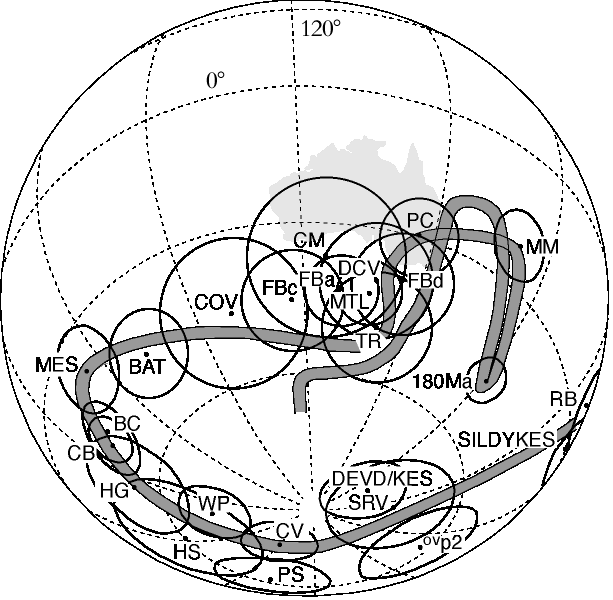D.A. Clark1 and M.A. Lackie2
1. CSIRO Exploration and Mining, 2. GEMOC Macquarie
This study provides reliable, well-dated and precisely defined Early Permian (285 ± 5 Ma) palaeomagnetic poles for Australia from the Mount Leyshon Igneous Complex (MLIC) and the Tuckers Igneous Complex (TIC). These data indicate that Australia occupied high latitudes in the Early Permian. The mean direction obtained from the MLIC is Dec = 196.3°; Inc = +77.4° (N = 34; k = 53.5; α 95 = 3.4°), while the mean direction obtained from the intrusive phases and the aureole of the TIC is Dec = 186°, Inc = +74° (N = 4; k = 216; α 95 = 6.3°). The pole positions are: MLIC: Lat = 43°S, Long = 137°E (dp = 6.0°, dm = 6.4°), TIC: Lat = 49°S, Long = 142°E (dp = 10.3°, dm = 11.4°). The primary nature of the Early Permian palaeomagnetic signature is established by full baked contact/aureole tests at both localities. Adjacent to the intrusions the host rocks are completely remagnetised and exhibit reversed polarity palaeomagnetic directions that are identical to those of the intrusions. At somewhat greater distances the country rocks bear a Permian overprint on a more ancient component and at sufficiently large distances the host rocks show no signs of Permian overprinting. Permian overprinting is detectable at considerable distances from the MLIC (2-3 km), well beyond the zone of visible alteration. Proximal overprinting is generally associated with secondary magnetite, but distal overprinting appears to be associated with precipitation of secondary hematite. A similar pattern of overprinting is found at the TIC, where the pronounced Permian overprinting persists well outboard of the biotite/secondary amphibole hornfels zone. However, the distal overprinting associated with the TIC appears to be purely thermal, with no evidence of secondary magnetic minerals outside the mappable hornfels zone.

Silurian-Cretaceous Apparent Polar Wander Path for Australia. Poles are shown with associated errors. TR, Tuckers Igneous Complex. MTL, Mount Leyshon Igneous Complex.

 GEMOC ARC National Key Centre
GEMOC ARC National Key Centre